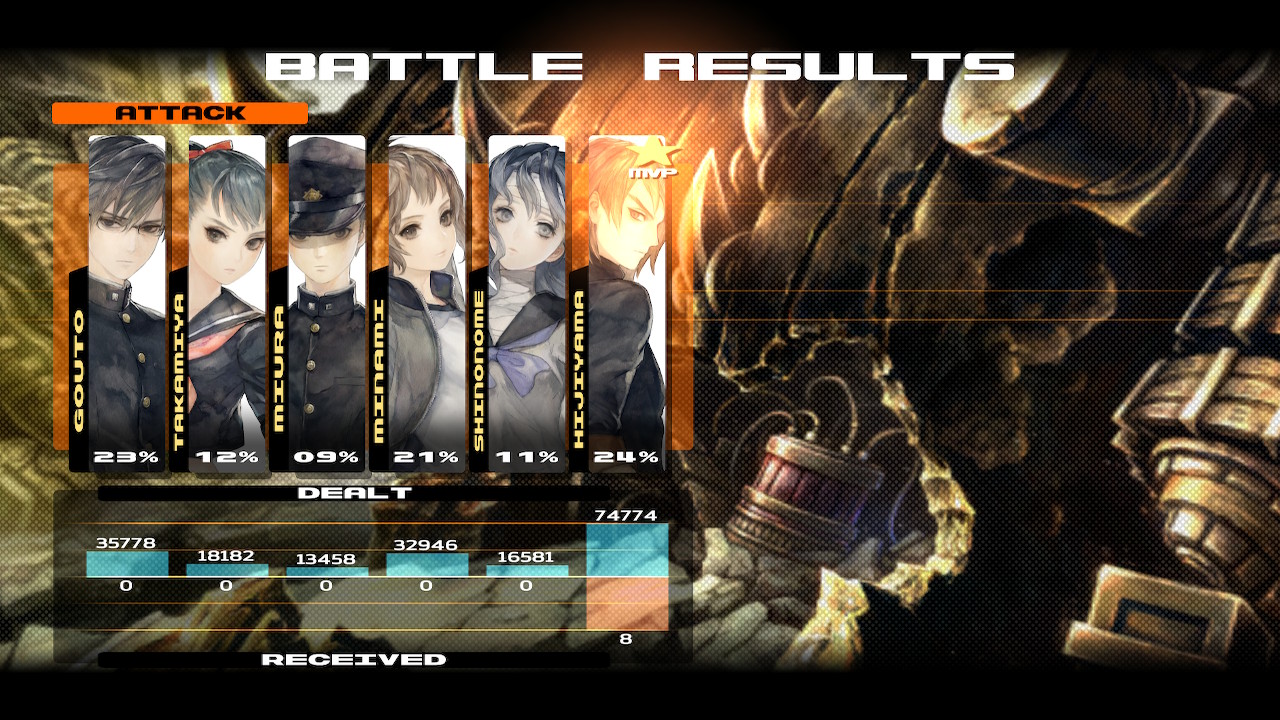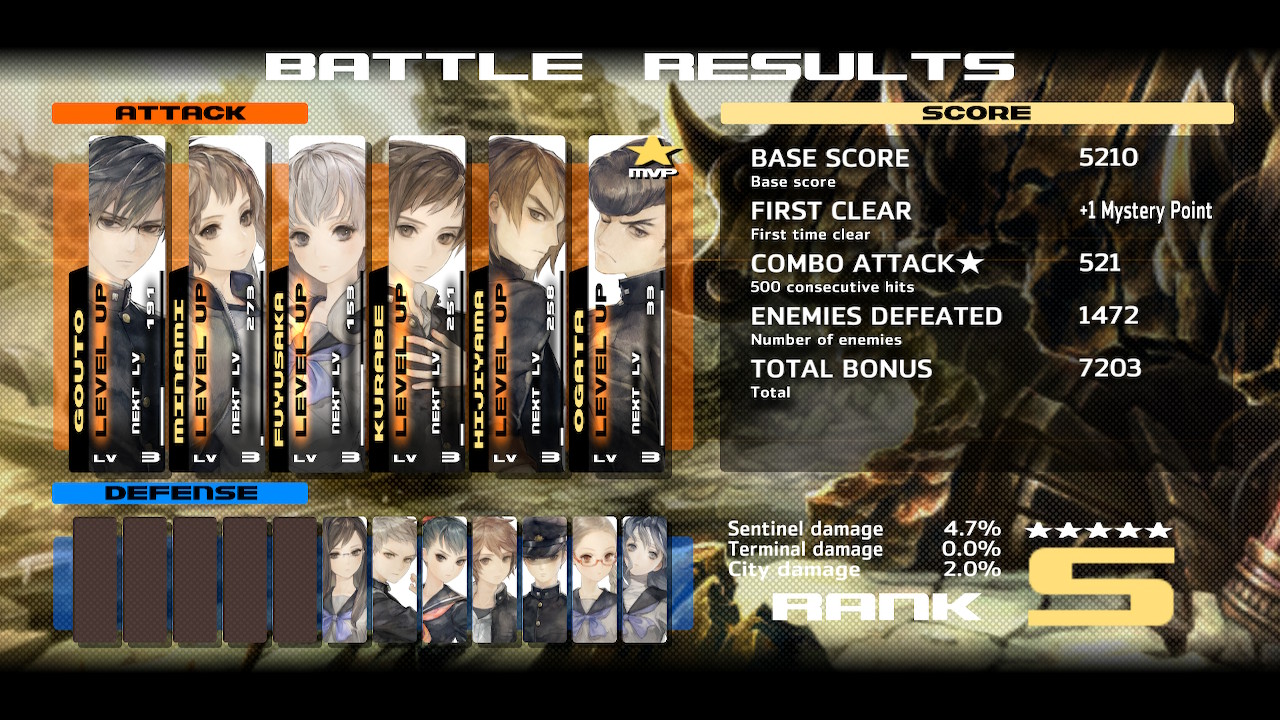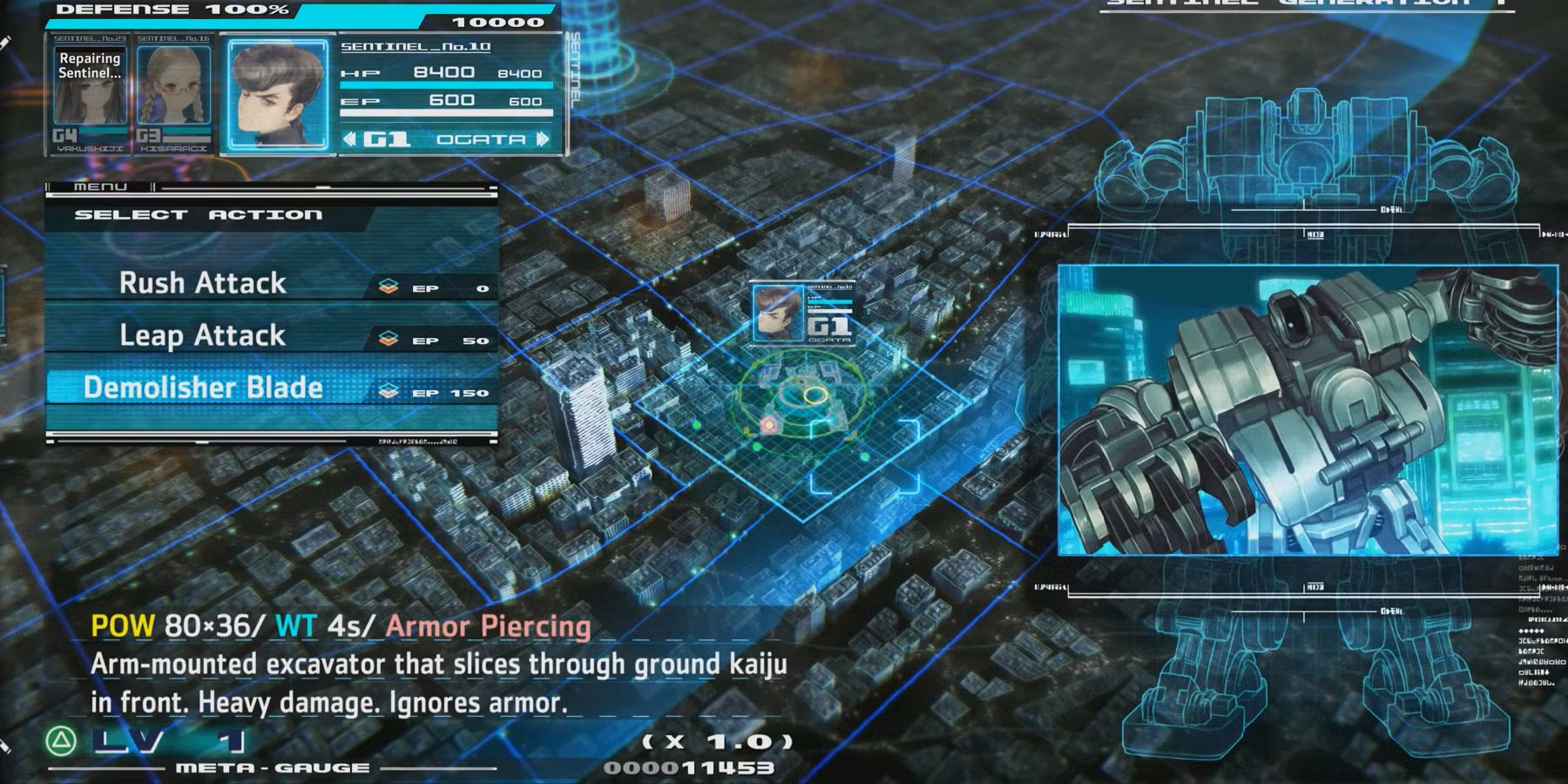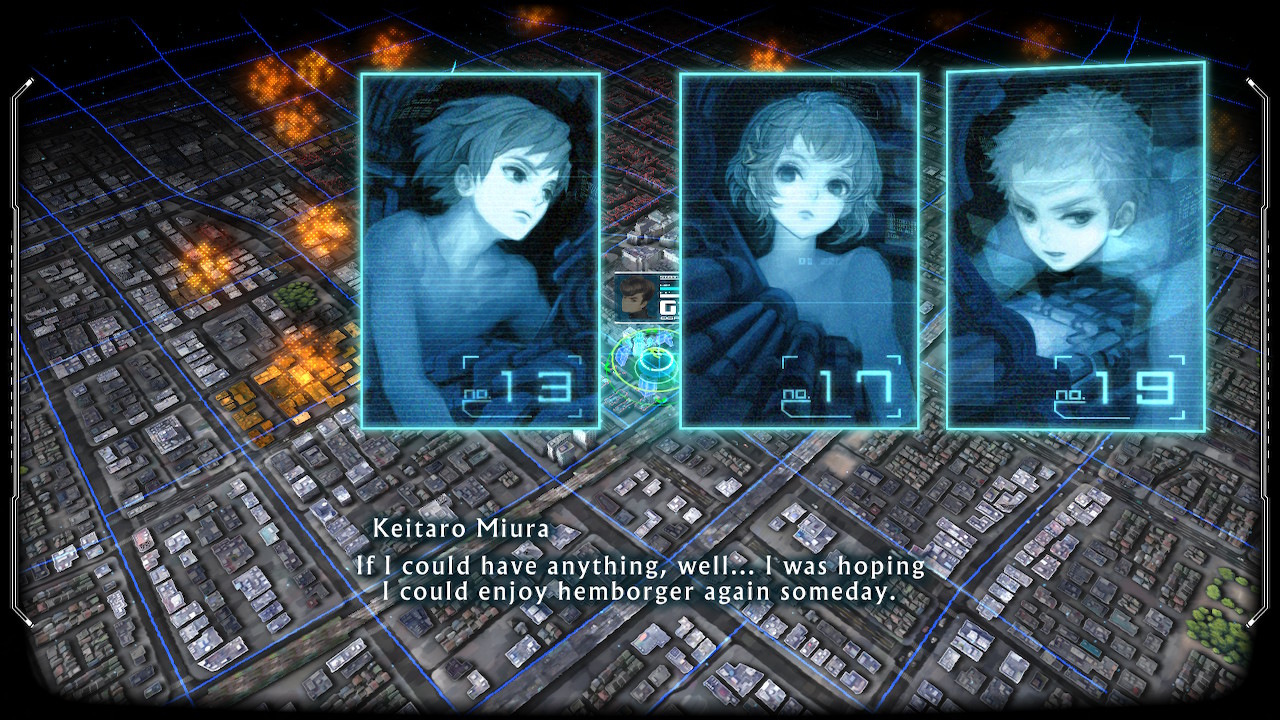posted: 2024-11-01
Floppy Numbers that Mean Nothing and The Combat of 13 Sentinels

Minimal spoilers for 13 Sentinels: Aegis Rim ahead.
What is a “floppy number”? I’d argue, it’s thirteen. Every number before thirteen has some from of intuitive meaning. It’s easy to look at a collection of eight objects and say “yes, there are two groups of four here”. Nine is a nice, friendly square number. Even 11 is interpretable from an overhead view once you see that it’s simply a group of ten and then one extra, or maybe that it’s an imbalance between two otherwise fine groups of five. But thirteen, well… Thirteen is a strange number, if you care to think about it (maybe for exactly thirteen seconds). It’s a prime number. It’s one more than three groups of four, which makes it a generally uneyeballable number. It’s an unlucky number here in the gool ol’ US of A. It’s 6 + 7 which feels as correct as 13 × 7 = 28 . So let’s call thirteen a floppy number, a number that has no intuitive meaning from just observing it. It certainly suits 13 Sentinels: Aegis Rim’s combat real-time strategy combat with its nebulousness of any and all important system numbers.
But I’m getting ahead of myself.
I generally enjoyed my 37 hours and 17 minutes split across two different types of gameplay spent with 13 Sentinels. It’s rare that a game with two entirely distinct modes has appealed to me in entirely separate ways. I will be honest, I would hardly consider myself an “enjoyer of high octane real-time strategy combat”. It’s a lot to juggle all at once and I can barely spin one plate before I start to get dizzy. It was thus a pleasure to have moments of the visual novel section to break up the intensity with an engaging approach to each story fragment. And maybe that was the goal. 13 Sentinels seems to understand that some, maybe most, people are approaching it from a “story-first” perspective, and so it goes to great lengths to encourage the trepidatious visual novel enthusiast to dip their toes into the decidedly not laid back nature of the RTS action. It’s lovely going about through one visually gorgeous story fragment after another, appreciating the wonderful voice acting and being gobsmacked by each new twist in the story. But, at some points the game says “hey buddy, I know you like devouring my rich, sugary, chocolate cake of a sci-fi plot, but I’m not gonna let you have anymore until you finish your vegetables.”.
And you know what, I don’t like eating asparagus in bed. I don’t like grabbing handfuls of spinach and shoving them down my gullet after a long day of work. Sometimes I can muster two stalks of celery on a Sunday morning, but that’s not something I’m going to just do. Not without a little planning at least. Sometimes vegetables taste great! I love a good bowl of steamed broccoli because it helps me feel like a healthy young man who gives a hoot about his health. But when you ask me to choose between a lovely dense, moist piece of chocolate cake, and a pile of thirteen flimsy, more yellow than green vegetables, I don’t think my decision is at all surprising.
I adore the visual novel sections of 13 Sentinels: Aegis Rim. I want to play more visual novels like it. I went and bought the Stein’s Gate bundle on Steam literally the same day I beat 13 Sentinels because I realized that at some point I would need to play the canon “best sci-fi visual novel” just to make sure that my appreciation of 13 Sentinels’s story and presentation doesn’t stem from the fact that I have literally never played a good visual novel (sorry Doki Doki Literature Club and every easily accessible Kotaro Uchikoshi game 1 2). I’m not going to be that asshole who Boss Baby tweets 3 all over an entire genre of video game, I am going to broaden my horizons, goddamn it. I loved how I was responsible for moving each playable character through their respective story fragments. A big wham-line gets dropped in a dialogue section, and then the game waits for me to press the action button, which thus allowing me to let my protagonist pause in the moment. It is immerse as heck and I loved every second of it. It captures the most unique aspects that interactive media can provide. An anime does not wait for you to process the twists from a scene before moving onto the next. A book will not give you a chronological road map of the plot and give you means contextualizing each story fragment. I know it sounds silly, but one of my favorite moments while playing the game came from having my character pace back and forth while going over every little “noun of interest” in their thought clouds. It brought me deeper into the game, which allowed me to appreciate the game’s story that much more.
It’s the RTS tower defense combat that ultimately dragged down the game from “all-time holistic favorite game” to “hey, that one was great, but I don’t need to play it again for a while and can’t necessarily recommend it without a few asterisks”. I have never played Starcraft, but I have to assume that this what it must feel like to the novice player. There is a sentinel’s-worth of systems lurking beneath the hood of this visual novel, and I do not understand a darn lick of it. As an aside, I think it would be really cool if you could play this game with 5 other friends and each play in real time each on your own systems, perhaps in a radon-heavy basement with one dude duct taped to the ceiling. Oh wait, I guess that’s just a LAN party, huh. Maybe I SHOULD try Starcraft…

“Unbelievable. I’m acting like an amateur!”
First and foremost, in each combat encounter, you can bring up to six sentinels, each piloted by one of the thirteen protagonists. Like any other remotely game designed game, each unit has specific traits and skills that allow them to accomplish a broad set of attacks. The Generation 1 Sentinels are heavy melee units while the Generation 3 units are focused more on ranged combat. This makes enough sense, sure. It’s when we start to unpack each unit that we start to discover just how many numbers there are.
Each unit has the traditional “stats”: HP, EP (Skill / Magic / Mana / what have you points), Power, Defense, Speed and Recovery Time. The problem with these stats is that I had absolutely no sense in what would be a “good” numerical value. It was not easy to develop an intuition towards what getting +13 Speed meant as I used my upgrade currency to upgrade my sentinels. There was not a clear benchmark and so I would look at my thirteen different sentinels and ask myself “how much stronger is Nenji Ogata compared to Ei Sekigahara?” Sure I could develop a feel on the battlefield, but this never translated to the numerical sense. One of the most important parts that I loved about the visual novel side of the game was the fact that I felt like I had control over the characters, yet here in the combat mode, I had no idea if boosting my units Power even one level made a meaningful difference. I could not tell if my actions, spending a currency-like set of points had meaningful consequences, which often made me feel quite wasteful.
I must admit, I didn’t realize there was a third menu which showed the effects of each character’s level up abilities until I was approximately 80% of the way through the combat side of the game. I guess I must have been blind? Maybe I just didn’t try pushing “left” a second time? I don’t know. I feel like there must have been signage, but I flat out didn’t see it. I know characters were getting level up abilities, but I never really gave them much thought. I’d accidentally execute and active some abilities over the course of waves and waves of Deimos attacks, but I never quite understood why they happened, or what they did as a result. I had no clue that Shu Amiguchi gets a significant stat boost for every additional female character included in the party once he reached Level 5. What kind of stat boost? What’s the magnitude of the boost? I couldn’t tell how this change compared to his baseline stats. Maybe I’m being nitpicky, but with everything else is already as vague as it is, I don’t mind piling on a few more complaints. Apparently Iori Fuyusaka gets an attack boost if she attacks immediately after another party member? And that this attack power gets multiplied if Ei Sekigahara is in the party? Sure? I can assure you that I had set up the circumstances that would activate these passive level-up abilities, but I had no visible understanding of the numbers behind them. Furthermore, once I DID understand the effects of each ability, I still had a difficult time observing their effects in battle. Despite his “desperation”-like ability, I cannot tell you I noticed a difference in Nenji Ogata’s damage output when he was at 100% HP versus 5% HP. These systems, with their invisible floppy numbers failed to leave an impact. Maybe if I had take the measures to accumulate these abilities I could observed a greater impact? It’s hard to say for certain. Though, I don’t think it really mattered whether or not I tried.
Maybe it was the fact that it was so easy to S-Rank each mission. I spent fifteen minutes dicking around on an abstraction of a city, moving my high-school piloted mechas across a space, listening to each of them repeat similar quippy dialogue blurbs, and then the game would tell me I somehow scored over 100,000 points and gave me a five-star S-Rank. I didn’t understand what I had done to deserve such a grandiose award. Not even an A-rank, but an S-Rank simply for completing the mission. I came to find that it was actually possible to score lower than an S-Rank: in one tricky section near the end of the game, I actually had two units lose enough HP to have the game warn me about their critical status. They didn’t die / become immobilized, but that was enough to drop me to an A-Rank (four stars, if you were curious and a quantifying kind of person). But I would venture to claim that even a modicum of strategery is enough to manage every encounter in the combat. It was so easy to get S-Ranks, that I actually stopped caring just enough to explicitly not get an S-Rank just to see what would happen.

I couldn't tell you how any of this translated into the gameplay feel.
Moments before getting an S-Rank, I would see a ticker line explaining my total scores. Line after line of “combos”, 1000 hits without damage, 2000 hits without damage, 3000 hits without damage, meta points, et cetera, et cetera. What the hell is a combo here? No genuinely, what the hell is a combo? As I understood it by the end of the game, it was the number of hits I made without taking responding damage. but you’re telling me I hit the enemy deimos over 3,000 times before I got hit with any units? I can understand how the melee-focused unitts might be able to rack up combos this way, but these combos are especially hard to keep in mind when I was using ranged attacks with Missle Rain, area-of-effect attacks with Rail Guns, and with the Sentry Guns that auto fire. If you asked me to intentionally rack up a 3,000 hit combo, I’d say that would be nigh impossible. Yet, there I was at the end of each fight with 1,000, 2,000, 3,000 hit combos that happened out of nowhere. Maybe I wasn’t paying enough attetion to what I was doing. Maybe I didn’t consider just how destructive Natusno Minani’s Wide-Range Rail Gun really was. These numbers may have had a physical meaning in the grand scheme of combat, but they were otherwise invisible as I played.
There are also some attacks that manage to hit multiple times in quick succession at a certain fixed damage, though this brings me to my next point. Quick, reader, I want you to pause right now: you have five seconds to multiply 80 × 36 in your head right now. Please pause for five seconds, now.

This is not mental math-able
As I write this I’m literally at an international science conference and at the social hours I’ve been asking people to do this quick multiplication in their heads and of the maybe thirty people I’ve asked, two could do it within a five second time window. I just wish there was an “effective damage” value: “This attack hits for 80 base damage, 36 times, which has an effective damage total of 2,880 damage”. Because gosh darn it when I’m bouncing around 4-6 units on an RTS platform trying to figure out what the best attack to use to maximize my damage out is, I would really prefer to not whip out the ol’ TI-84. Because of the floppiness of these numbers, I always ended up just choosing the “big number attack” and hoping it was enough. Yuki Takemiya’s “Leg Spike” and “Quad Leg Spike” attacks were only examples to the contrary. By the final battle, the Leg Spike did 1430 × 2 damage, while the Quad Leg Spike did 1030 × 4 damage. This was a strong and intuitive set of numbers. There are two legs to do Leg Spikes, and the attack hits twice! Quad Leg Spikes implies that the sentinel is attacking four times, and sure enough that translates into the damage math. I don’t want to argue that every attack has to have a literal interpretation, but rather, it was only through the cases were the math was extremely simple did I actually have an idea of how much damage I was going to do. I do not want to hear anyone say “oh get good at math, bozo”. Pal, I quite literally have a degree in applied mathematics. To quote Mike Matei in his inspiration performance as Inspector Gadget, “You can shut up now”.
Floppy numbers are the reason why I struggle to recommend 13 Sentinels: Aegis Rim to anyone and everyone. That doesn’t mean that I hated the experience, far from it, in fact! Playing this game was a wonderful time! However, it is crucial to be critical about the things we enjoy so that we can present our most honest and unclouded feelings. I absolutely loved the narrative of 13 Sentinels and I would highly encourage you to, if nothing else, watch a video probably titled “13 Sentinels: Aegis Rim - The Movie”. The combat, while fun, was never engaging enough to incite a desire. I never sought out the combat side of the game, and only played it when it was absolutely necessary. When I was in the thick of it, sure, I was having a good time. But I never felt compelled to explore the inner mechanics deeper than “bigger number is better”. In that sense, the unclear, “floppy” numbers of every single RTS system in 13 Sentinels is enough to give me pause in my recommendation. Go try it for yourself, see if you liked the overall package more than I did. If you did, great! I’m happy for you! And if you find that, like me, you don’t really care for the combat, you’re still getting an excellent visual novel on the other half.
not sorry Danganronpa, I’m glad you’re dead :]↩︎
just kidding i could never hate you super danganronpa2 goodbye despair shsl lucky student nagito komaeda↩︎
an evergreen tweet that can be used to poke fun at people who are only exposed to one example of a medium / genre, who then use the example as their reference. A common example: calling any form of jazz “persona 5 music”.↩︎

yeah